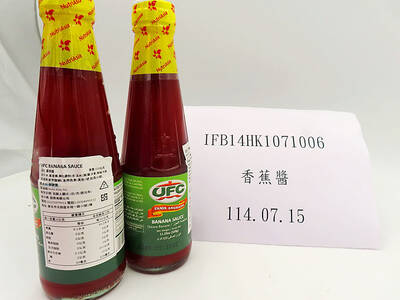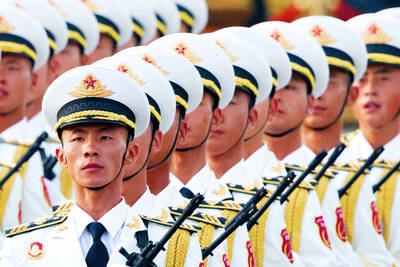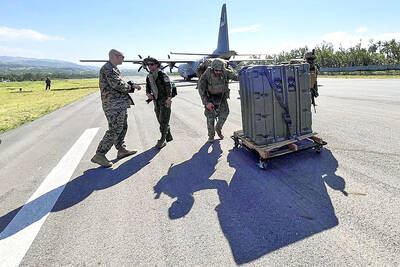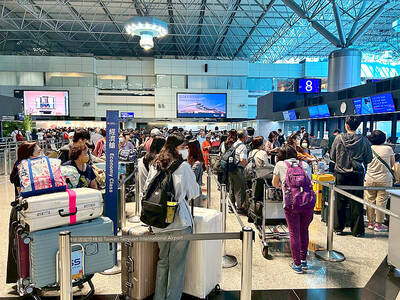The government is aiming to make Taiwan the dominant player in the global semiconductor supply chain, with annual output topping NT$2.66 trillion (US$82.9 billion) by 2028, the Executive Yuan said yesterday.
The goal was set to fulfill President William Lai’s (賴清德) pledge of developing five “trusted industry sectors,” semiconductors, artificial intelligence (AI), defense, cybersecurity and surveillance, and next-generation communications.
The National Development Council has been charged with formulating action plans to meet those pledges, which were approved at the weekly Cabinet meeting yesterday.

Photo: Sam Yeh, AFP
“The development of the five trusted industry sectors is President Lai’s national policy vision and has strategic significance,” Executive Yuan acting spokeswoman Julia Hsieh (謝子涵) quoted Premier Cho Jung-tai (卓榮泰) as saying.
“Not only would that bolster Taiwan’s status in the global supply chain, as well as links to the nation’s democratic allies, but it would also help every industry in the nation maintain its competitiveness. It is also the key to creating high-paying jobs, and enhancing national security and resilience,” she said.
The goal of developing the semiconductor industry is to solidify Taiwan’s No. 1 status in the foundry and packaging and testing industry, and become one of the world’s top two nations in integrated circuit design, the council said.
By 2028, half of the chips produced in Taiwan should be using advanced manufacturing processes, it said.
Output values generated by semiconductor material and chip manufacturing equipment industries should increase by NT$52.8 billion and NT$80 billion respectively, the council said.
The overall output of the semiconductor industry is expected to be NT$2.66 trillion by 2028, creating 250,000 high-paying jobs, it added.
The government has also set a goal of generating more than NT$1 trillion by 2026 through the development of the AI industry, the council said, adding that 200,000 AI specialists would be trained within four years.
The application rates of AI systems in the digital economy and manufacturing industries should be increased by 50 percent and 30 percent respectively, the council said.
A smart and energy-conserving data center would be built to enhance Taiwan’s influence in the global AI industry, it said.
Regarding the defense industry, the government aims to become the first democratic supply chain center for drones in the Asia-Pacific region, with annual output value growing 10-fold to reach NT$30 billion by 2028, the council said.
The drone manufacturing industry should be capable of quickly raising monthly drone production capacity by 150,000 units should there be a rise in short-term demand, it said.
For the development of the aerospace industry, a production line for engine forgings would be established, the council said.
By 2028, 165 new sea vessels for the navy and Coast Guard Administration would be delivered, the council said.
To build a nationwide resilient next-generation communication network, the government plans to support the research and development of base stations for 6G communication technology, with 80 percent of the hardware and software being made in Taiwan, the council said.
Taiwan would also be able to develop and manufacture ground communications equipment for low Earth orbit satellites, with 80 percent of key communication components being manufactured domestically, the council said.
The nation is aiming to launch its first B5G low Earth orbit satellite in 2027 as part of the initiative to build out a satellite communication system, it said.
Other goals include developing cybersecurity and surveillance technology industries with generated output values of NT$100 billion and NT$30 billion respectively.
The Executive Yuan yesterday also approved a Ministry of the Interior plan to train 50,000 disaster-prevention specialists as part of a government initiative to bolster rescue capacity in the private sector.
A study on the Great Hanshin Earthquake that occurred in Japan’s Hyogo Prefecture on Jan. 17, 1995, showed that 34.9 percent of people escaped from disasters caused by the earthquake on their own, while 31.9 percent were able to do so with the help of family members.
About 28 percent said they escaped through assistance from neighbors and friends, Minister of the Interior Liu Shyh-fang (劉世芳) said.
“The experience has caused many governments to begin strengthening the self-help and mutual assistance capabilities among civilians in times of natural disasters, aside from governments’ disaster-prevention capacity,” Liu said.

Three batches of banana sauce imported from the Philippines were intercepted at the border after they were found to contain the banned industrial dye Orange G, the Food and Drug Administration (FDA) said yesterday. From today through Sept. 2 next year, all seasoning sauces from the Philippines are to be subject to the FDA’s strictest border inspection, meaning 100 percent testing for illegal dyes before entry is allowed, it said in a statement. Orange G is an industrial coloring agent that is not permitted for food use in Taiwan or internationally, said Cheng Wei-chih (鄭維智), head of the FDA’s Northern Center for

The Chinese military has built landing bridge ships designed to expand its amphibious options for a potential assault on Taiwan, but their combat effectiveness is limited due to their high vulnerability, a defense expert said in an analysis published on Monday. Shen Ming-shih (沈明室), a research fellow at the Institute for National Defense and Security Research, said that the deployment of such vessels as part of the Chinese People’s Liberation Army (PLA) Navy’s East Sea Fleet signals a strong focus on Taiwan. However, the ships are highly vulnerable to precision strikes, which means they could be destroyed before they achieve their intended

LOOKING NORTH: The base would enhance the military’s awareness of activities in the Bashi Channel, which China Coast Guard ships have been frequenting, an expert said The Philippine Navy on Thursday last week inaugurated a forward operating base in the country’s northern most province of Batanes, which at 185km from Taiwan would be strategically important in a military conflict in the Taiwan Strait. The Philippine Daily Inquirer quoted Northern Luzon Command Commander Lieutenant General Fernyl Buca as saying that the base in Mahatao would bolster the country’s northern defenses and response capabilities. The base is also a response to the “irregular presence this month of armed” of China Coast Guard vessels frequenting the Bashi Channel in the Luzon Strait just south of Taiwan, the paper reported, citing a

About 4.2 million tourist arrivals were recorded in the first half of this year, a 10 percent increase from the same period last year, the Tourism Administration said yesterday. The growth continues to be consistent, with the fourth quarter of this year expected to be the peak in Taiwan, the agency said, adding that it plans to promote Taiwan overseas via partnerships and major events. From January to June, 9.14 million international departures were recorded from Taiwan, an 11 percent increase from the same period last year, with 3.3 million headed for Japan, 1.52 million for China and 832,962 to South Korea,